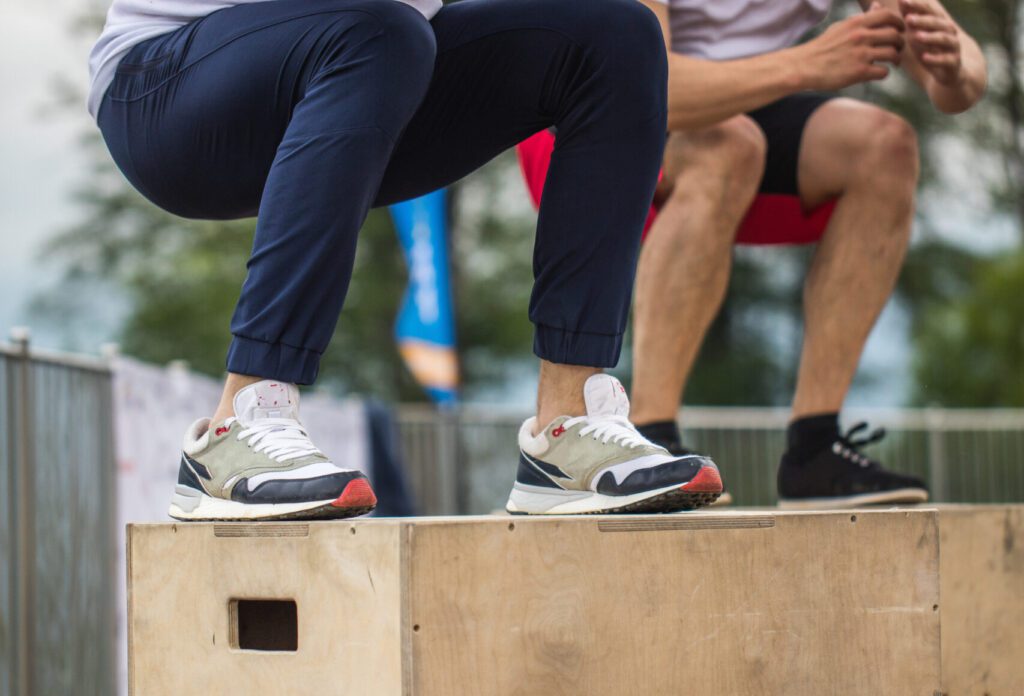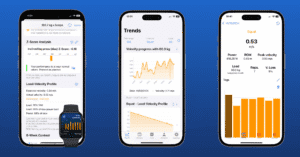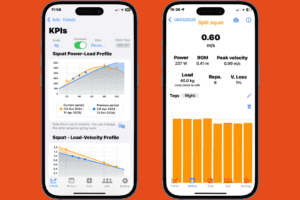To determine sports power measurement experts rely on the combination of high and fast jumps. Both athletes and coaches should understand the methods to test and enhance explosive strength in their training plans. This test provides important data about athletic power through its exercises.
This article explains how the drop jump test is a plyometric exercise used to measure an athlete’s lower body power and reactive strength. It involves dropping from a height and immediately jumping upward as high as possible upon landing
But that’s not all! Our following section will explain how Spleeft App supports your workouts by tracking live results including athletic performance indicators and measuring physical fatigue. Let’s jump in! 💥
DOWNLOAD SPLEEFT APP NOW FOR iOS, ANDROID AND APPLE WATCH!
Drop Jump Test:
What Does the Drop Jump Test Measure?

Sports scientists widely use the drop jump test as their fundamental measurement tool to evaluate how fast athletes react and how strong they can explode. To determine how an athlete converts impact absorption into quick force production the drop jump provides the best information available.
Key Metrics of the Drop Jump Test:
Reactive Strength Index (RSI): This is the main metric. It’s calculated by dividing the height of the jump by the time the athlete spends in contact with the ground. The higher the jump and the faster the ground contact time, the better the RSI, indicating better explosive power. 💪 This metric has been shown to be a critical factor for understanding an athlete’s plyometric capacity and efficiency during the transition phase in jumping [1][2].
Jump Height: This measures the vertical distance an athlete can achieve after landing from a height. A higher jump typically reflects better lower-body power [1].
Contact Time: This refers to how long the athlete’s feet stay in contact with the ground after landing, which is crucial for determining how efficiently they transition into their jump [3].
Together, these metrics give coaches a comprehensive understanding of an athlete’s capacity for explosive movement. But the power of this test extends beyond just these numbers — it’s the ability to track improvement over time and optimize training plans accordingly.
Drop Jump Test Protocol: A Step-by-Step Guide
You need specific defined steps to properly execute the drop jump test. Here’s a basic rundown:
Set-Up: The athlete stands on a platform (usually between 20 and 100 cm in height). The exact height can vary based on the athlete’s level of experience and goals [1].
The Drop: The athlete steps off the platform and lands on the ground. The goal is to absorb the impact by flexing the knees and immediately transitioning into a jump [1][2].
The Jump: As soon as the athlete lands, they explode into a maximum vertical jump. The goal is to minimize the contact time and maximize jump height [2][3].
To get good results you must precisely measure contact time and jump height during every trial. Performing several drop tests at distinct drop heights helps create a reactive strength profile through testing [2].
What to Remember:
The athlete should keep their hands on their hips to avoid arm swings influencing their movement [1].
Before starting the test you must warm up for safety and success.
Take many jump attempts to measure variations from normal performance and effects of tiredness.
Why Fatigue Matters in the Drop Jump Test
The drop jump test isn’t just about raw strength — it’s about how well an athlete can maintain their performance under fatigue. And this is where it gets really interesting! Spleeft App can track fatigue during jump tests by monitoring the velocity loss between jumps. As fatigue sets in, an athlete’s performance will usually decline, meaning their jump heights might decrease or their contact times might increase.
Spleeft App can analyze this and show you how well you’re maintaining performance as you progress through a training session. This is crucial for understanding how your nervous system is holding up during intense sessions, allowing you to adjust training loads accordingly.
Tracking Fatigue with Spleeft App:
Spleeft uses real-time velocity tracking and jump height analysis to give you instant feedback during training. If you notice a significant drop in jump height or an increase in contact time, it could be a sign of fatigue, which may influence the adjustments you need to make to the training load [5].
How Spleeft App Helps You Measure Jump Performance
Spleeft App takes the guesswork out of jump training by providing precise, real-time data on each jump you make. Whether you’re testing your drop jump performance or working on improving your vertical, Spleeft delivers the metrics that matter. Here’s how:
1. Jump Height Measurement:
Spleeft determines your jump height from the time your feet stay off the ground. You can get this information directly from your phone or Apple Watch without using force plate equipment. After completing each jump the app shows you updated results right away to help you see your progress or weak areas [6].
2. Fatigue Tracking:
Spleeft measures velocity loss during each jumping movement you complete. The tool helps you detect how quickly you are losing your jumping ability. The drop jump performance of athletes usually drops when they become exhausted. Spleeft helps you detect power loss during training to prevent overtraining by letting you change workout intensity after each repetition [7].
3. Instant Feedback and Data Analytics:
Spleeft offers live performance tracking, showing metrics like jump height, velocity, and fatigue. This data helps you understand your progress in real-time, allowing you to adjust your training accordingly and get the most out of every session [7].
Why Track the Drop Jump Test?

The drop jump test is a gold standard for assessing an athlete’s reactive strength and explosive power, making it incredibly valuable for performance training in sports like basketball, volleyball, track and field, and football.
But tracking jump performance doesn’t stop there. The beauty of tools like Spleeft App is that they allow athletes to constantly monitor improvements, assess fatigue, and adjust their training on the fly. It’s not just about testing; it’s about continuous improvement.
How Drop Jumps Translate into your Vertical Jump
One important aspect of jump training is understanding how to translate drop jump to vertical jump ability. While both tests measure explosive power, the drop jump focuses more on how quickly the body can transition from absorbing impact to producing force. In contrast, a vertical jump measures your ability to generate power from a standstill position.
Tracking both tests over time can show you how much your reactive strength (as measured by the drop jump) is improving and how it’s influencing your vertical jump. This is especially useful for athletes looking to increase their jump height for sport-specific purposes. 🏀
Equipment Needed for the Drop Jump Test
Conducting a drop jump test requires a few pieces of essential equipment:
Elevated Platform or Box: The height is typically between 20 and 100 cm, depending on the athlete’s training level.
Jump Height Measurement Tools: Traditionally, this could involve specialized devices or manual timing methods. However, with Spleeft App, you can easily measure jump height using your phone or Apple Watch. Spleeft uses time-of-flight data (the time your feet are off the ground) to provide accurate and real-time jump height measurements without the need for expensive or complex tools.
Cameras or Video Recording (optional): Helpful for analyzing form and technique.
For most athletes, some traditional tools can be expensive and impractical for regular use. However, Spleeft App offers an affordable, easily accessible alternative that allows you to track these metrics with just your phone or Apple Watch! 📱⌚️
Unlock Your Explosive Potential
The drop jump test is one of the best ways to measure lower-body explosiveness and assess an athlete’s reactive strength. Whether you’re a coach looking to evaluate your athletes or an individual aiming to level up your jump performance, the drop jump provides the insights you need.
But you don’t have to stop there! Spleeft App makes it easier than ever to track your jump performance and fatigue in real-time, helping you make smarter decisions about your training. By integrating cutting-edge technology with scientifically proven methods, you can boost your performance and train more efficiently.
So, what are you waiting for? Measure your drops, track your progress, and jump your way to greatness with Spleeft App!
References
- Bobbert, M. F., Huijing, P. A., & van Ingen Schenau, G. J. (1987). Drop jumping. I. The influence of jumping technique on the biomechanics of jumping. Medicine and Science in Sports and Exercise, 19(4), 332-338.
- Byrne, P. J., Moran, K., Rankin, P., & Kinsella, S. (2010). A comparison of methods used to identify ‘optimal’ drop height for early phase adaptations in depth jump training. Journal of Strength and Conditioning Research, 24(8), 2050-2055.
- Flanagan, E. P., & Comyns, T. M. (2008). The use of contact time and the reactive strength index to optimize fast stretch-shortening cycle training. Strength & Conditioning Journal, 30(5), 32-38.
- Komi, P. V., & Bosco, C. (1978). Utilization of stored elastic energy in leg extensor muscles by men and women. Medicine and Science in Sports, 10(4), 261-265.
- Laffaye, G., Wagner, P. P., & Tombleson, T. I. (2014). Countermovement jump height: Gender and sport-specific differences in the force-time variables. Journal of Strength and Conditioning Research, 28(4), 1096-1105.
- McGuigan, M. R., Doyle, T. L., Newton, M., Edwards, D. J., Nimphius, S., & Newton, R. U. (2006). Eccentric utilization ratio: effect of sport and phase of training. Journal of Strength and Conditioning Research, 20(4), 992-995.
- Pedley, J. S., Lloyd, R. S., Read, P., Moore, I. S., & Oliver, J. L. (2017). Drop jump: A technical model for scientific application. Strength & Conditioning Journal, 39(5), 36-44.
Iván de Lucas Rogero
MSC Physical Performance & CEO SpleeftApp
Dedicated to improving athletic performance and cycling training, combining science and technology to drive results.





